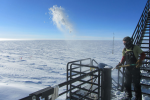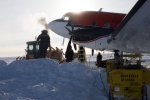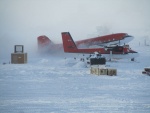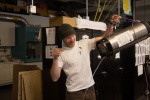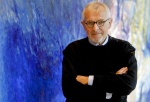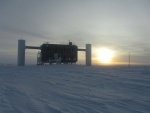Tuesday, November 11, 2014 - 8:00am
There’s a bit of prep work involved in getting the station ready for its summer opening. IceCube winterovers Ian and Dag used this time to perform an IceTop snow survey and to finish up snow removal around the ICL.
Wednesday, November 5, 2014 - 11:00am
For a place that receives so little precipitation, there’s an awful lot of snow around. So much snow that bulldozers are sometimes enlisted to move it out of the way, as shown here in front of this parked Basler aircraft.
Monday, November 3, 2014 - 1:00pm
Deep in the ice at the South Pole, the IceCube Neutrino Observatory sits and waits for high-energy particles to pass in its midst. However, another detector, DM-Ice, is situated among IceCube’s strings, partnering with its technology for a different purpose: the search for dark matter.
Monday, October 27, 2014 - 2:30pm
Puebla is again seeing dozens of physicists wandering in their streets these days, as researchers from the High-Altitude Water Cherenkov (HAWC) Observatory get together for their biannual collaboration meeting.
Monday, October 27, 2014 - 12:15pm
After the sun’s arrival come the planes. The first of the season to reach the South Pole were a pair of Twin Otters, one of which appears parked in the image above.
Tuesday, October 21, 2014 - 8:30am
Water restrictions prompt innovation. When already limited showers get rationed even further, as they have been recently at the South Pole station, you start thinking of ways to work around the problem.
Friday, October 17, 2014 - 12:30pm
Francis Halzen, the University of Wisconsin-Madison physicist who was the driving force behind the giant neutrino telescope known as IceCube at the South Pole, has been named a winner of the 2014 American Ingenuity Award.
Thursday, October 16, 2014 - 10:00am
Ah, the things we take for granted. Sunshine might be one of them. Running water might be another. At the Pole, sometimes you have to do without.
Tuesday, October 14, 2014 - 3:15pm
The High-Altitude Water Cherenkov Observatory (HAWC) is designed to study the sky in TeV gamma rays and observe the most energetic objects in the known universe. Due to its size and location, the observatory will also observe millions of cosmic rays every day, allowing for very precise measurements of the cosmic-ray anisotropy.
Wednesday, October 8, 2014 - 2:00pm
The second Fermi-VERITAS-HAWC workshop begins today in Madison, Wisconsin, at the University of Wisconsin–Madison’s Union South. The two-day workshop will engage physicists from around North America, encouraging discussion among the three different collaborations.

